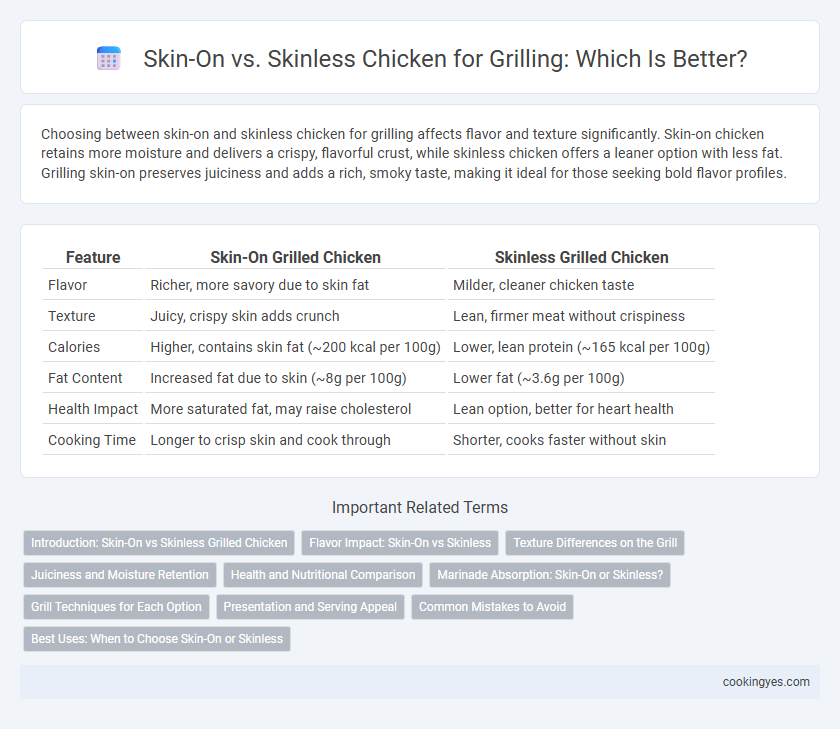Choosing between skin-on and skinless chicken for grilling affects flavor and texture significantly. Skin-on chicken retains more moisture and delivers a crispy, flavorful crust, while skinless chicken offers a leaner option with less fat. Grilling skin-on preserves juiciness and adds a rich, smoky taste, making it ideal for those seeking bold flavor profiles.
Table of Comparison
| Feature | Skin-On Grilled Chicken | Skinless Grilled Chicken |
|---|---|---|
| Flavor | Richer, more savory due to skin fat | Milder, cleaner chicken taste |
| Texture | Juicy, crispy skin adds crunch | Lean, firmer meat without crispiness |
| Calories | Higher, contains skin fat (~200 kcal per 100g) | Lower, lean protein (~165 kcal per 100g) |
| Fat Content | Increased fat due to skin (~8g per 100g) | Lower fat (~3.6g per 100g) |
| Health Impact | More saturated fat, may raise cholesterol | Lean option, better for heart health |
| Cooking Time | Longer to crisp skin and cook through | Shorter, cooks faster without skin |
Introduction: Skin-On vs Skinless Grilled Chicken
Chicken skin enhances flavor and retains moisture during grilling, resulting in juicier and more tender meat. Skinless grilled chicken offers a leaner option with lower fat content, appealing to health-conscious consumers. Choosing between skin-on and skinless depends on desired texture, taste, and nutritional preferences.
Flavor Impact: Skin-On vs Skinless
Skin-on grilled chicken delivers a richer flavor due to the fat rendering from the skin, which bastes the meat and enhances juiciness. The Maillard reaction on the crispy skin creates a deep, savory crust that intensifies the overall taste experience. Skinless chicken lacks this fatty layer, resulting in a leaner, milder flavor profile but can dry out more easily during grilling.
Texture Differences on the Grill
Grilling chicken with the skin on locks in moisture, producing a crispy, flavorful crust while keeping the meat tender and juicy. Skinless chicken tends to cook faster and can dry out more easily, resulting in a firmer, less succulent texture. Choosing skin-on chicken enhances texture complexity by combining a crunchy exterior with a moist interior, ideal for grilling.
Juiciness and Moisture Retention
Skin-on grilled chicken retains more moisture and juiciness due to the fat layer that locks in natural juices during cooking, preventing the meat from drying out. Skinless chicken tends to dry faster on the grill because it lacks this protective barrier, often requiring marination or basting for improved moisture retention. Choosing skin-on cuts ensures a tender, flavorful result with enhanced succulence compared to skinless options.
Health and Nutritional Comparison
Grilling chicken with skin on preserves moisture and enhances flavor but increases fat content and calorie intake compared to skinless chicken. Skinless grilled chicken provides a leaner protein source with fewer saturated fats, making it a healthier option for heart-conscious diets. Essential nutrients like protein remain high in both forms, but skinless chicken supports lower cholesterol levels and reduced risk of cardiovascular diseases.
Marinade Absorption: Skin-On or Skinless?
Skinless chicken absorbs marinades more effectively than skin-on because the absence of skin allows direct contact between the meat and the flavorful ingredients, enhancing flavor penetration. Skin-on chicken creates a barrier that limits marinade absorption but helps retain moisture and juiciness during grilling. For maximum seasoning impact, skinless cuts provide better marinade infusion, while skin-on offers a balance of flavor and moisture retention.
Grill Techniques for Each Option
Grilling chicken with the skin on requires medium heat to render the fat and achieve crispy, flavorful skin while keeping the meat juicy. For skinless chicken, higher direct heat and shorter cooking times help prevent dryness and ensure even cooking. Using a marinade or basting sauce enhances moisture retention and adds flavor regardless of skin presence.
Presentation and Serving Appeal
Skin-on grilled chicken offers a visually appealing golden-brown, crispy texture that enhances presentation and entices diners, while skinless chicken provides a cleaner, more uniform appearance favored in health-conscious or fine dining settings. The skin's natural oils render during grilling, contributing to a glossy finish that elevates serving appeal and pairs well with vibrant herbs and sauces. Opting for skin-on chicken can create a rustic, hearty presentation, whereas skinless cuts lend themselves to minimalist plating and precise portion control.
Common Mistakes to Avoid
Grilling chicken with skin-on preserves moisture and enhances flavor, but common mistakes include failing to properly score the skin, which can cause uneven cooking and flare-ups. Choosing skinless chicken often leads to drying out if the grill temperature is too high or cooking time is too long, resulting in a tough texture. Avoiding these errors ensures juicy, evenly cooked grilled chicken with optimal taste.
Best Uses: When to Choose Skin-On or Skinless
Choose skin-on grilled chicken for juicy, flavorful results and when aiming for crispy, golden skin that locks in moisture during high-heat grilling. Opt for skinless chicken when preparing leaner, lower-fat meals or marinating for quick cooking, allowing the flavors to penetrate directly into the meat. Skin-on cuts excel in bone-in recipes or longer grilling sessions, while skinless pieces are ideal for quicker, evenly cooked dishes like chicken breasts or kabobs.
Skin-On vs Skinless for Grilled Chicken Infographic

 cookingyes.com
cookingyes.com